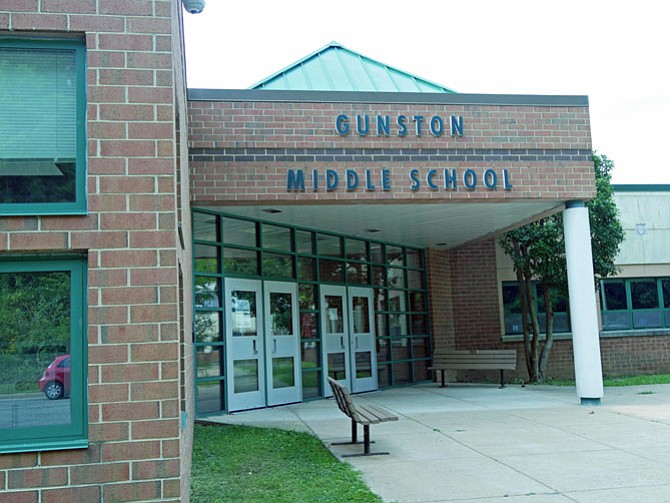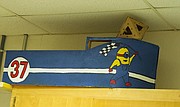The curriculum at Gunston Middle School, located at 2700 S. Lang St., includes a continuation program for the students from Key Elementary and Claremont Elementary schools who had attended the Spanish immersion programs. Photo by Shirley Ruhe/The Connection
First in a series of five focusing on Arlington Middle Schools.
Handbooks are ready, supplies have been ordered and teachers have been getting acquainted with their new classrooms. Dr. Lori Wiggins, principal at Gunston Middle School, located at 2700 S. Lang St., says her enrollment is projected at 940 this year, up like everywhere else. "One thing that distinguishes our middle school in the county is that it is a partial Spanish immersion school for about one-third of the students who attended the Key Elementary or the Claremont Elementary Spanish Immersion program. They take Science, Social Studies and Spanish Language Arts entirely in Spanish,” she said, adding “the foundation they have from elementary school helps them master the middle school content in Spanish."
There are other language opportunities as well including French, which has now grown to five sections, Latin with about 30 students and Chinese and Arabic with about 25 students each. She says Chinese and Arabic are long distance learning which can be a challenge to keep the interest of the students but as the technique gets better, the obstacles will be overcome.
There are eight periods of the day. Five core subjects are required in sixth grade with one elective and four core subjects with two electives in seventh and eighth grades, plus physical education and lunch.
If a student has band, strings or chorus, he or she can also choose to take the elective wheel which she calls the "post-it note of learning." A student rotates through a number of electives every 20 days or so and when the 20 days is over can take off the post-it note and try something else. This can give them a taste of subjects like drama, art, or journalism.
As she walks through the tech ed classroom, she points to the corner: "We built people-size boxcars and had a race; today tech ed is much more than woodshop.” In addition they have a 3-D printer for digital design. She picks up a small, gray rhinoceros that was designed on the printer and formed into anl object.
Wiggins says she thinks school is a petri dish reflection of society. As a result, education incorporates technology. "It doesn't mean they don't need a teacher to learn and create. But it is a change from the teacher having all of the knowledge in the room since the students can access their computer. It is a shift in the way knowledge is delivered."
She reflects about diversity: "Last year we had children from about 70 different countries in our school. In addition, we have a number of children of military parents from places like Portugal and Turkey. This means thinking about how information is delivered to students and parents and special needs or assistance." After-school library and computer access are available for students who may need extra help or who don't have access at home. Since Gunston Community Center is next door, the students can also go back and forth after school and use the resources offered there. There are late buses so that students can avail themselves of the extra assistance.
Wiggins has learned, that with this diversity, communication will take a little longer. She creates opportunities to celebrate the cultural richness with school festivals focusing on different dress and sharing foods from the diverse countries represented at the school. At Thanksgiving Gunston returns the cultural exchange. "It would warm your heart, " she said, "when we host a Thanksgiving-themed dinner with turkey and mashed potatoes."
"Middle school years are a great, great age," she said. At a conference she attended recently they were described as "the four years between teddy bears and college" and so she adds, "it's no wonder they are the crazy years. They have a lot going on and kids like to try out a lot of things." But, she says, they are learning life skills in the middle school classrooms.
"Arlington's commitment to arts and sports is very strong although sometimes I have to find how to do more with less,” she said. But anyone can play a sport here. We have the cut sports like basketball and tennis with a finite number of players, but anyone can dive or wrestle and we have track and soccer." Their mascot is the hornet and their school colors purple and teal.
Wiggins was licensed in California, taught public schools three years in New York. She says each state has its own licensing requirements as well as required years teaching, a Master’s degree and endorsement by school administration in order to be a principal.


